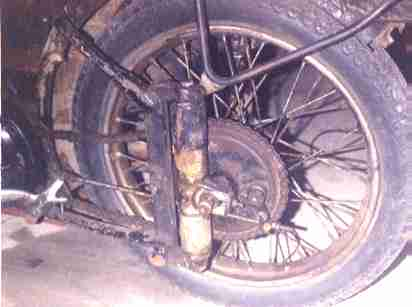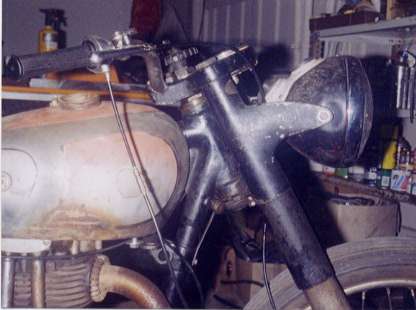Shock, horror, discovery, frustration, dismay and a glimmer of hope.
Now -- Success!! It started.
The basket case - a 1951 plunger frame with a 1950 engine. The bike was purchased in dismantled condition and appears to have been a 'paddock basher' for some time before resting in a shed for 15 years.The previous owner purchased it in this condition (refer to photos), dismantled the bike and lost interest (and some parts).








General Notes
This probably should be a blog. Since purchasing the project I purchased a complete 1954 Swingarm ES2 (refer to the photos page) and have spent a lot of time riding it rather than completing the project. Most of the project's clutch has been stolen at some time or other to keep the '54 going. The '54 has some wonderful engineering mods performed by previous owners that really weren't necessary because the real problems were due to mismatched parts in the clutch.The best piece of advice I can give is measure, measure and measure again. Nothing is exact and nothing is the 'same'. Just because a part came from a similar bike doesn't mean that it is the correct one. These machines are over fifty years old and have probably had many owners and many changes made to them.
Clutch
Ensure that the three clutch springs and cups all match. Measure the length of the springs, uncompressed,
compressed and also the thickness of the wire.
The 'old guy' had a collection of springs that were too thick and would make the clutch so stiff it
would be suitable for a Mac truck. He also had springs that were wound the wrong way so that they unwound
the securing bolts. They all came from new bikes and he replaced them with the correct springs when
the bike came to his workshop.
The Norton clutch is really very simple. The bolts , which are short, should be screwed all the way down so that they bed down and not be too long or they will bottom out and come loose (happened on the '54). The clutch basket was totally stuffed but eventually someone found a replacement. The rubbers were petrified. Make up a tool (instructions in the manual) and replace the rubbers each time the clutch is removed.
Seat mounts
The mounts were hacked off to use a dual seat (I think). These have been remade and fixed in place. The Norton seat has a long bracket on the front. Most other seats do not fit. I used a generic seat and added the nose bracket.Frame
No bends or dings. Has now been bead blasted, primed and painted. Lesson: Never assume. I had not checked the centre stand lugs when preparing the frame and later noticed that the lugs were half eaten away (the bike has been a paddock basher and experience many years of grinding on rocks and probably many years of corrosive cow manure) and would not stand up [no pun intended] to the strain of holding a centre stand. Nearly completed and had to be stripped down again (2007-11)
Steering head races
New (replacement) races have been installed.
Fork forks
Springs were cracked and had been brazed together. An old mechanic tested one and handed it
back in two pieces with the comment, 'Better to find out now than later!' The replacement
springs are Triumph with almost identical dimensions. The stanchions were badly pitted from,
age, neglect and the brazed springs. These were turned down 15 thou along the bush travel zone
and new bushes made to suit.
The shrouds have been loose in the past and chewed by the springs.
New ones are being made. They have painted up well and the fit seems OK.
The springs are too short. Having had the springs out of the '54 and measuring everything the springs need to be longer. The springs in the '54 need to be longer as well to remove a slight sag in the front. Purchsed new springs - they willgo in on the next strip down. Beware the front axle pinch bolt. Over tighten it and you will create a lot of work for yourself. Overtightening will snap the bottom of the left fork leg. If in doubt insert a washer in the gap when tightening. Be aware that the pinch bolt may have been overtightened in the past and it will snap when you own it.
Plungers
The shrouds were badly beaten and holed. New ones are being made. I could not find a source for these anywhere. The remade spring covers sat on the bike for a year because I could not work out how to stop the headlight ears from moving off the spring covers. My replacement covers did not have the top lip/groove. This lip holds the thin lip on the fork ears. Aargh! my fork ears have no lip. Someone has broken / ground them off. Look for replacement fork ears.
There is a cap over the the steering head bearing. This is essential for spacing in the steering head - if it is missing , the headlight ears

